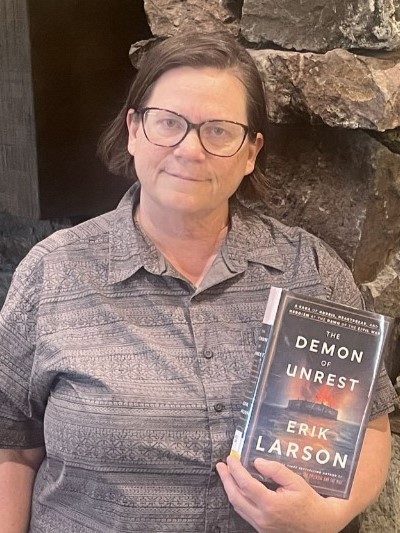Director of Library Operations Pam Parker recommends The Demon of Unrest: A Saga of Hubris, Heartbreak, and Heroism at the Dawn of the Civil War by Erik Larson.

Readers of Erik Larson’s other noteworthy historical exposés, such as The Devil in the White City (2003), will find familiar territory in his new Civil War-themed work, The Demon of Unrest (2024). I found this latest effort to be surprisingly suspenseful considering that the Civil War is a subject about which plenty has already been written.
Noting that some 16,000 biographies about Abraham Lincoln have been published, Larson has intentionally avoided ‘Honest Abe’ as a subject. It took the pandemic – and a trove of primary resources uncovered during lockdown – to renew his interest. The result of his deep dive is a vivid portrait of our nation’s fatal divide over state’s rights and slavery and…
…for the reader, a better understanding of why this conflict came to be.
Larson subtitles this work, A Saga of Hubris, Heartbreak and Heroism at the Dawn of the Civil War. Beginning in late 1860 with the election of Lincoln, the focus is primarily on the growing Southern discontent and the resulting push for secession. More specifically, he follows the building tension in and around Charleston, South Carolina, which became the first state to secede from the Union.
As Larson leads us through the months of early 1861, the looming unrest builds as does our sense that Lincoln will not be able to avoid war between the states.
Among the many other interesting characters is U.S. Army Major Robert Anderson, who we get to know through his letters home to his wife. We also get an insider’s view on the state of the Union via his pleading correspondence to his superiors as he’s left in command of Fort Sumter in Charleston Bay with little direction and too few provisions. Nearby, Confederate forces are gathering in significant numbers and an attack seems imminent.
The resulting battle marks the beginning of Civil War and forms the backbone of this richly layered story.
Ultimately, The Demons of Unrest is a success precisely because Larson avoids chronicling the war in an exhaustive fashion. He narrows in on a handful of participants whose first-hand accounts describe how their lives collided with the unrest. In the powerful epilogue, he wraps up their stories at war’s end in 1885, by which time over a half million had died and countless lives have been irrevocably impacted.
As readers, we have gained hindsight into how a political divide over slavery became a Civil War.
This powerfully crafted book places Larson among my personal favorites and is further evidence that he deserves the label of “modern master” in this genre of narrative nonfiction. I hope his next efforts – and, yes, another book is underway but he’s withholding on the topic – include more on American history. His ability to incorporate personal accounts in creative ways makes for highly engaging reads that are sure to keep you turning the pages.
Find it in print, ebook, and eaudiobook in our Collection here.
You’ll find another fascinating book in our Collection: Campfires and Battlefields. Originally published in 1894, Campfires and Battlefields: the Pictorial History of the Civil War has continued to be in print over the years and remains an important historical record of the period.
